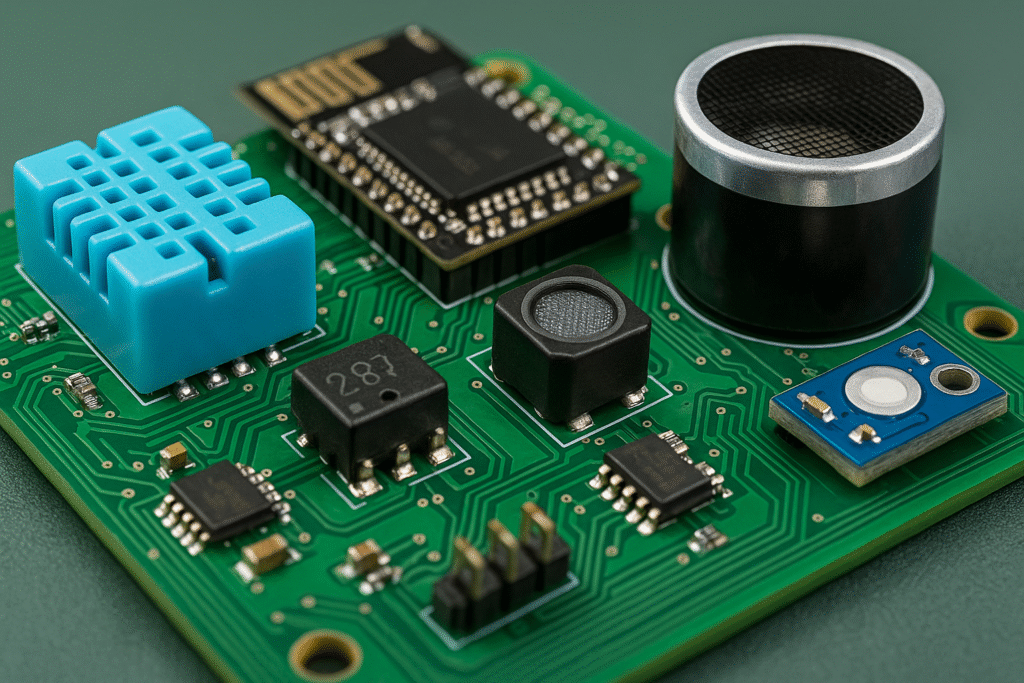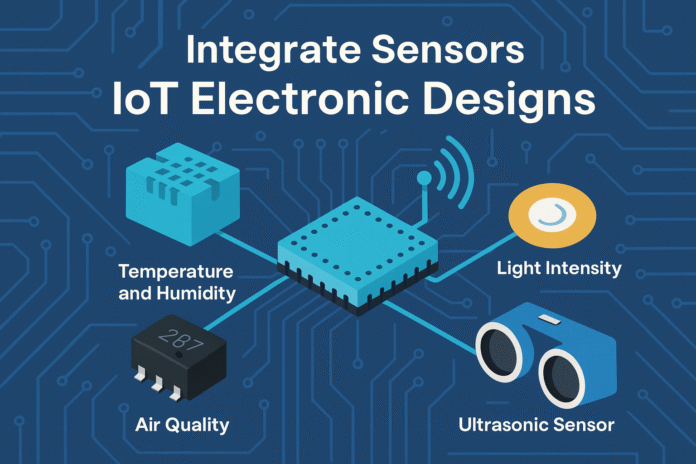When engineers and product developers ask how to integrate sensors into IoT electronic designs, they are often looking at how physical data can be reliably captured, processed, and transmitted across networks. Whether the application is in smart homes, industrial automation, medical devices, or environmental monitoring, sensors are the foundation of IoT functionality. Successful integration not only depends on selecting the right sensor but also on designing efficient circuits, optimizing pcb design, and implementing secure data pathways. This article will walk through how sensors are used in IoT systems, what types of sensors are most common, and how best to integrate them into your electronic designs.
How to Implement IoT Sensors?
Implementing IoT sensors starts with understanding the end application. The process involves several stages:
- Defining system requirements: Engineers must identify the parameters to measure (temperature, pressure, humidity, motion, etc.), data precision needed, and environmental conditions.
- Sensor selection: Based on accuracy, operating range, interface compatibility, and cost.
- Circuit and PCB design: Proper placement, grounding, and signal conditioning are critical for accurate readings.
- Communication protocol integration: IoT sensors must connect via wired (I2C, SPI, UART) or wireless (Wi-Fi, Bluetooth, LoRa, Zigbee) channels.
- Firmware development: Software handles calibration, data sampling, and communication with gateways or cloud servers.
- Testing and validation: Performance must be verified under real-world conditions before deployment.
Implementation is rarely just a plug-and-play exercise. It involves balancing sensor performance with power consumption, PCB layout constraints, and system reliability.
What Are Integrated IoT Sensors?
Integrated IoT sensors refer to components that combine sensing, processing, and communication capabilities into a single package. Rather than using discrete sensors with separate microcontrollers, these integrated solutions offer efficiency and smaller form factors. Examples include:
- Bosch BME680: Measures temperature, humidity, pressure, and gas, with digital output for IoT devices.
- InvenSense MPU-6050: Combines a 3-axis gyroscope and accelerometer.
- Texas Instruments CC2650 SensorTag: Bundles multiple sensors with Bluetooth connectivity for IoT prototyping.
These integrated sensors simplify hardware design, reduce PCB real estate, and speed up time-to-market. However, they may limit flexibility when compared to modular sensor systems.
How Are Sensors Used in IoT?
Sensors in IoT perform three main roles: data collection, event detection, and environment interaction.
- Data collection: Environmental sensors collect continuous streams of data, such as temperature in HVAC systems or air quality in smart cities.
- Event detection: Motion detectors or vibration sensors trigger alerts in security systems or predictive maintenance setups.
- Interaction: Sensors feed control loops, allowing systems to act on environmental changes. For example, light sensors adjust smart lighting, and soil moisture sensors activate irrigation systems.
The choice of sensor depends on the intended outcome. In healthcare, IoT devices might use biometric sensors for patient monitoring, while in logistics, RFID and GPS modules track shipments in real time.
What Is Integration of Sensors in System Design?
Sensor integration in system design means embedding sensors into the electronic, mechanical, and communication architecture of an IoT device. Proper integration is not only about connecting wires but about harmonizing three design aspects:
- Hardware design: PCB layout, analog-to-digital conversion, and power regulation for sensors.
- Software design: Drivers, libraries, and firmware to interpret sensor signals.
- System-level architecture: Cloud connectivity, edge computing, and interoperability with other IoT components.
Integration requires attention to signal conditioning. Sensors often output weak or noisy analog signals, which must be amplified and filtered before conversion to digital signals. This makes analog circuitry design as important as digital logic when working with IoT devices.
What Are the 4 Sensors in IoT?
While IoT covers hundreds of sensor types, four categories are considered fundamental:
- Temperature sensors – Used in HVAC systems, refrigerators, industrial process monitoring, and wearable electronics.
- Proximity sensors – Essential in retail automation, parking systems, and smart doors.
- Pressure sensors – Used in automotive tire systems, weather stations, and industrial machines.
- Accelerometers/gyroscopes – Found in smartphones, wearables, and robotics to detect movement and orientation.
These four represent a foundation, but modern IoT often involves combinations of multiple sensor types integrated into a single device.
How Does IoT Integration Work?
IoT integration involves connecting sensors, processing units, and communication interfaces into a coherent system. The flow typically looks like this:
- Sensing layer: Sensors collect physical data.
- Processing layer: Microcontrollers or embedded processors condition and interpret signals.
- Communication layer: Data is sent to gateways via wireless (e.g., LoRaWAN) or wired protocols.
- Application layer: Cloud platforms or edge devices analyze and visualize data, triggering insights or actions.
Effective IoT integration requires secure data transfer, low-latency communication, and reliable power management. Engineers must consider how devices scale within a larger network, especially when designing for smart cities or industrial IoT.
PCB Design Considerations for IoT Sensors
Since IoT devices often rely on miniaturization and low power consumption, PCB design plays a vital role in sensor integration. Key considerations include:
- Sensor placement: For temperature sensors, avoid proximity to heat-generating components. For accelerometers, place them near the device’s center of mass.
- Analog vs digital traces: Keep analog sensor lines isolated from high-speed digital lines to reduce noise.
- Grounding: Proper grounding and shielding techniques are critical for accurate sensor readings.
- Power regulation: Sensors may require multiple voltage levels; regulators must be designed efficiently.
- Antenna integration: When IoT devices include wireless modules, antenna placement must be optimized for signal strength.
A poorly designed PCB can compromise even the most advanced sensors, leading to inaccurate data or device failure.
Common Communication Protocols for IoT Sensors
Integrating sensors into IoT electronic designs also means choosing the right communication method:
- I2C: Simple and widely supported, ideal for multiple low-speed sensors.
- SPI: Faster than I2C, used for sensors requiring higher data rates.
- UART: Traditional serial communication, often used with GPS modules or modems.
- Wireless (Wi-Fi, BLE, LoRa, Zigbee): Used when sensors need to communicate over distance.
Choosing the right protocol depends on trade-offs between power consumption, speed, and scalability.
Security in IoT Sensor Integration
One often overlooked aspect of sensor integration is security. Since IoT devices transmit sensitive data, protecting communication channels is vital. This includes:
- Encrypting data between sensors and gateways.
- Using secure boot and firmware validation.
- Ensuring OTA (over-the-air) updates are authenticated.
Without secure integration, IoT devices may become vulnerable to cyberattacks, putting networks and users at risk.

Challenges in Integrating Sensors into IoT Electronic Designs
Some of the most common challenges include:
- Power consumption: Many IoT devices are battery-powered, requiring low-power sensor operation.
- Environmental reliability: Sensors must withstand harsh environments in industrial or outdoor applications.
- Interoperability: IoT devices must integrate with various platforms and standards.
- Scalability: Systems need to handle hundreds or thousands of sensors without bottlenecks.
These challenges require a holistic approach, balancing hardware design, software optimization, and system-level architecture.
Future Trends in IoT Sensor Integration
The future of sensor integration in IoT will likely involve:
- AI-driven edge computing: Processing data locally on microcontrollers to reduce cloud dependence.
- Energy harvesting sensors: Using solar or vibration energy to power sensors, extending lifetime.
- MEMS advancements: Smaller, more accurate micro-electromechanical sensors for wearables and robotics.
- 5G IoT connectivity: Allowing low-latency integration of massive sensor networks.
As IoT expands into healthcare, agriculture, smart cities, and aerospace, sensor integration will continue to evolve, demanding more sophisticated designs.
Conclusion
To successfully integrate sensors into IoT electronic designs, engineers must balance hardware constraints, communication needs, and system performance. From selecting the right sensor to designing an efficient PCB and implementing secure communication protocols, every stage plays a critical role. While challenges like power consumption and scalability remain, advancements in integrated sensors and IoT platforms make it easier than ever to build intelligent connected devices. The future will see even tighter integration, with AI and energy harvesting reshaping how sensors function in electronic systems. Pairing solid pcb design principles with modern IoT strategies is the best way forward for engineers aiming to create reliable, scalable, and intelligent IoT solutions.
